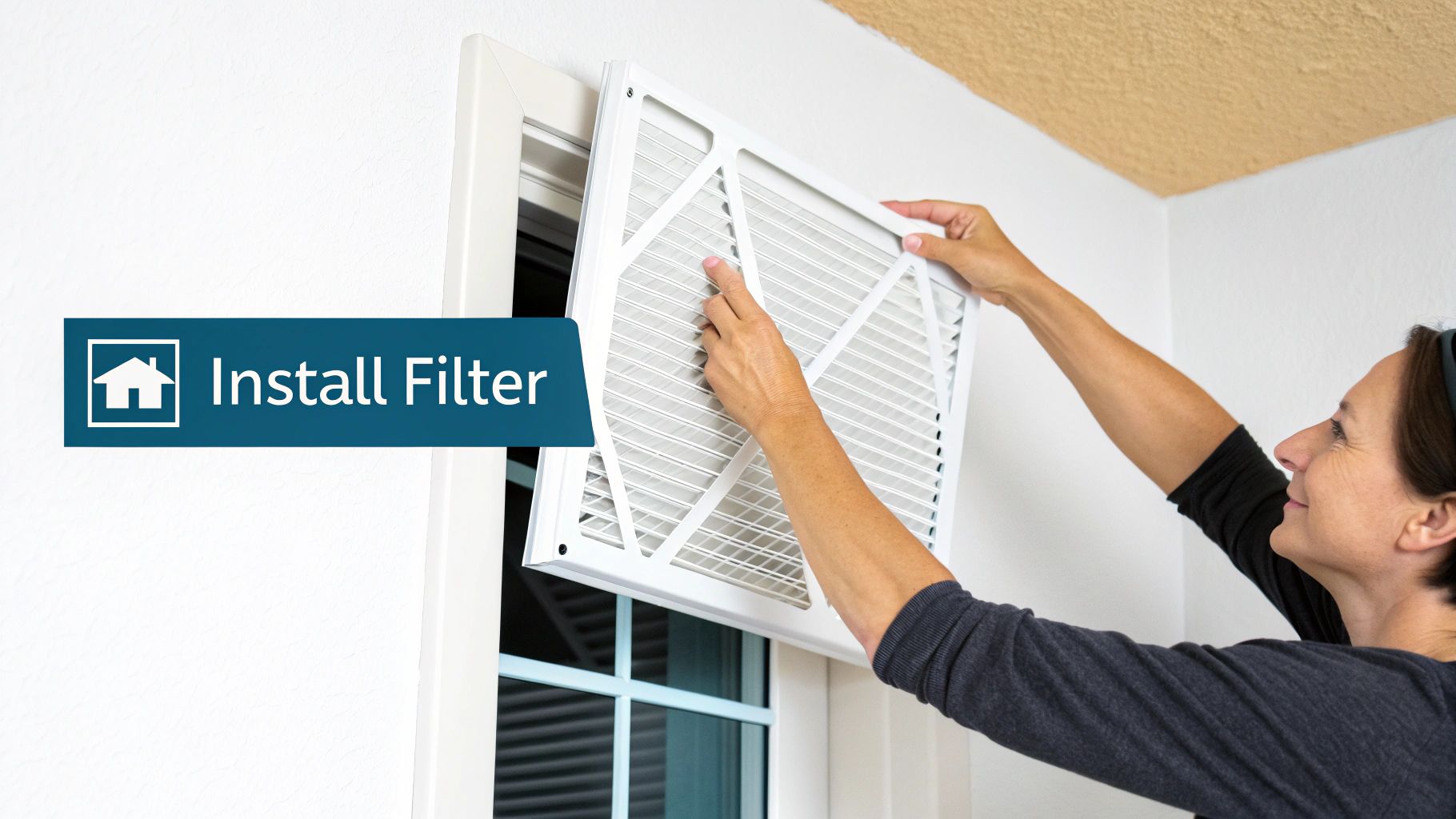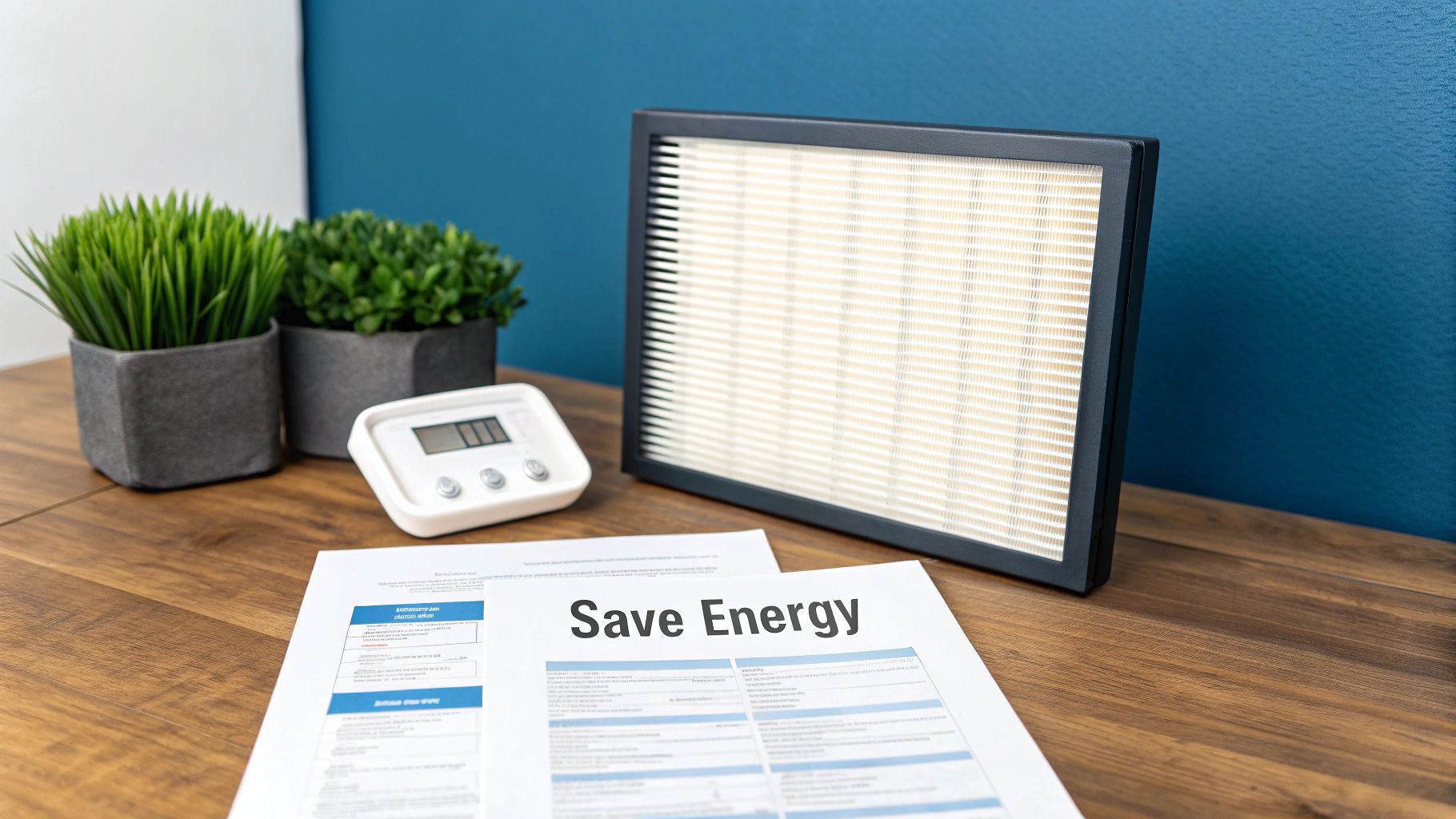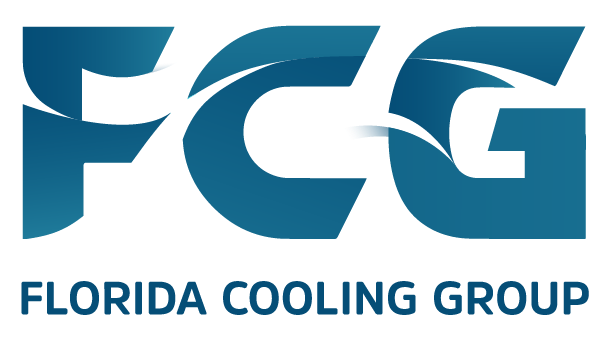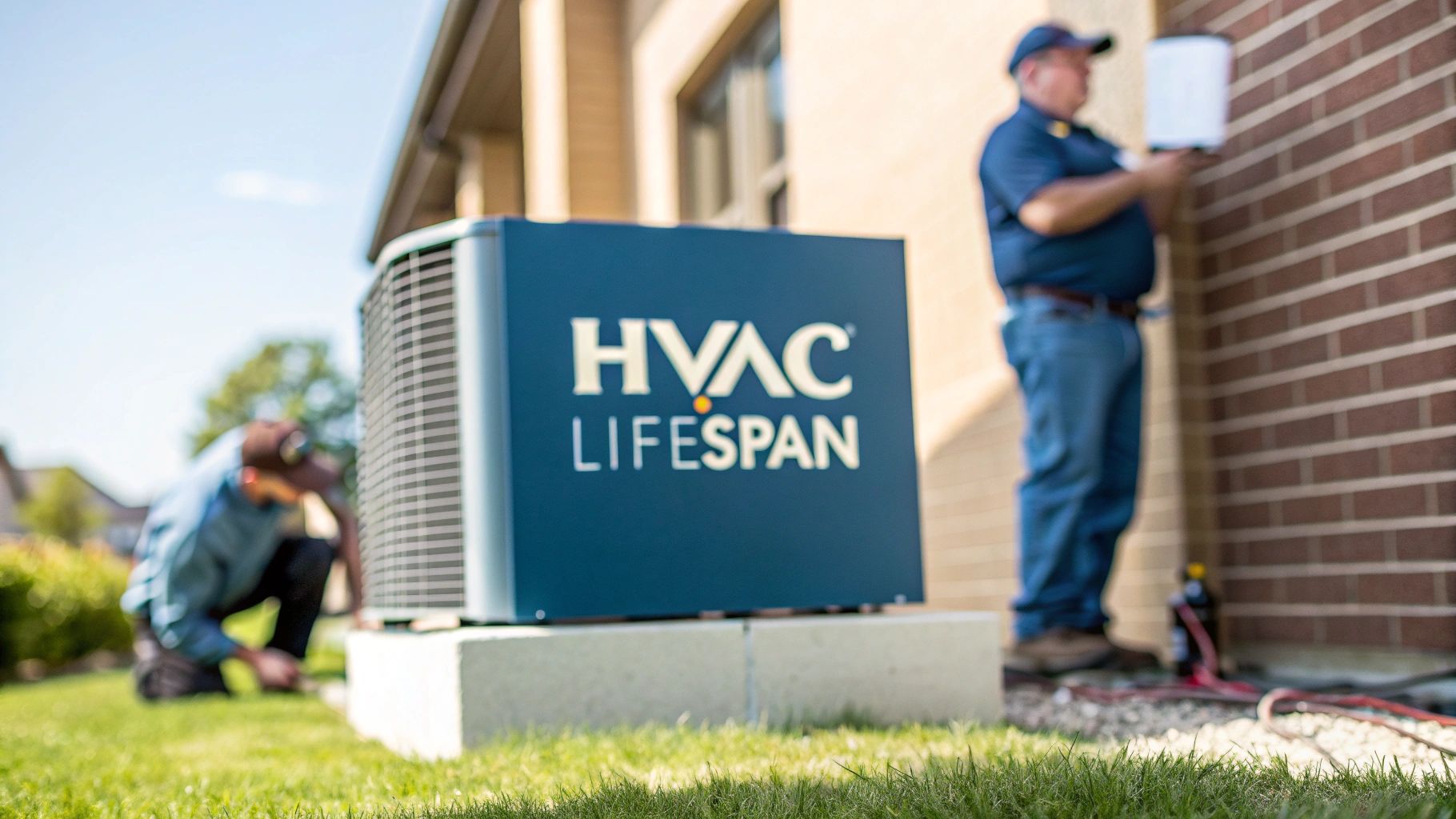Think of the air filters in your home's vents as the unsung heroes of your HVAC system. They're more than just simple screens; they are your first line of defense, capturing a surprising amount of dust, allergens, and other gunk before it gets circulated throughout your living space.
Essentially, they act as the guardians for both your expensive HVAC equipment and the air you breathe every day.
Your Home's First Line of Defense Against Dust
Imagine your home's HVAC system is like its respiratory system. It pulls air in, conditions it, and then "exhales" it back into your rooms. The air vent filter is what keeps those lungs clean, working 24/7 to make sure the air your family breathes is as fresh as possible.
This guide will cut through the confusing jargon and technical specs. We'll give you the practical, real-world advice you need to understand these crucial components of your home.
Why Air Filters Are More Than Just a Screen
A good air filter does so much more than just catch the obvious dust bunnies. Its real job is to trap microscopic particles that can impact your health and the longevity of your HVAC system. The benefits really add up.
- Better Health: A quality filter snags airborne irritants like pollen, pet dander, mold spores, and even bacteria that can trigger allergies and asthma attacks.
- HVAC Protection: Keeping dust and debris from building up on sensitive mechanical parts helps your system run efficiently and can help you avoid some seriously expensive repair bills down the road.
- A Cleaner Home: It’s simple—the more dust your filter traps, the less of it settles on your furniture, floors, and shelves. That means less time spent cleaning.
These simple devices are foundational to creating a healthy indoor environment. For a broader understanding of how you can maintain a healthy home environment, explore various methods for improving indoor air quality.
The Growing Focus on Clean Indoor Air
More than ever, homeowners are paying close attention to the quality of the air inside their homes. This heightened awareness is driving major growth in the filtration market.
In fact, the residential air filter market is projected to hit a value of around $5.81 billion in 2025, with continued growth expected through 2033. This trend is almost entirely fueled by a better understanding of how indoor pollutants can affect our respiratory health. You can learn more about the rise in residential air filtration on archivemarketresearch.com. With the market expanding so quickly, this guide will help you make a smart choice.
Making Sense of MERV Ratings and Filter Types
Ever stood in the filter aisle at the hardware store feeling completely overwhelmed? You’re not alone. With a wall of options and a bunch of acronyms like MERV and HEPA staring back at you, picking the right one can feel like a pop quiz you didn't study for.
But here's the good news: understanding what makes a good filter is simpler than it looks. It all starts with one key concept: MERV.
What Exactly Is a MERV Rating?
MERV stands for Minimum Efficiency Reporting Value. It’s just a simple 1-20 scale that tells you how well a filter catches airborne particles.
Think of it like this: a low-MERV filter is like a wide net that only catches the big fish—things like lint and big dust bunnies. A high-MERV filter, on the other hand, is a much finer net, capable of snagging tiny particles like pet dander, pollen, and even smoke.
To help you visualize this, here’s a quick breakdown of the MERV scale and what each level is good for.
MERV Rating and Filtration Capability
| MERV Rating | Captures Particles Like… | Best For |
|---|---|---|
| 1-4 | Dust, lint, carpet fibers | Basic HVAC protection; minimal air quality improvement. |
| 5-8 | Pollen, dust mites, mold spores | Good for most homes; a solid baseline for cleaner air. |
| 9-12 | Pet dander, auto emissions, legionella | Great for homes with pets or moderate allergy sufferers. |
| 13-16 | Bacteria, tobacco smoke, fine particles | Superior filtration for people with asthma or severe allergies. |
As you can see, the right MERV rating for your home really depends on what you're trying to filter out.
It's All in the Materials
A filter's MERV rating comes down to what it's made of. Different materials are designed to do different jobs.
- Fiberglass Filters: These are your classic, cheap, blue filters. They have a very low MERV rating and are really only designed to protect your HVAC system from large debris. They don't do much for your air quality.
- Pleated Filters: This is a huge step up. By pleating fabric like cotton or polyester, these filters create a much larger surface area to trap particles. They hit that sweet spot of good filtration and airflow, usually landing in the MERV 6-12 range.
- Electrostatic Filters: These are pretty clever. They use self-charging fibers that act like a magnet for airborne particles, pulling them out of the air. Many are washable and reusable, which can save you money in the long run.
Your air filter is essentially the first line of defense for your HVAC system, which you can think of as the lungs of your home.

This image really drives home how the filter stands guard, capturing all the gunk before it can get into the sensitive parts of your system and cause problems.
Finding Your Home's Sweet Spot
You might think, "Higher MERV is always better, right?" Not so fast. A filter with a super-high MERV rating can be so thick and dense that it actually chokes your HVAC system.
This restriction in airflow forces the system to work overtime just to push air through. The result? Higher energy bills and a lot of unnecessary strain on your equipment, which can lead to costly repairs down the road.
For the vast majority of homes, a MERV rating between 8 and 13 is the perfect balance. This range is effective enough to capture common culprits like pollen, pet dander, and mold spores without making your HVAC unit struggle.
This is especially critical when considering a cold air return vent filter, as these are central to your system's overall health and efficiency.
Your goal is to find the highest MERV rating your HVAC system can handle without sacrificing airflow. Your unit’s manual is the best place to start, but when in doubt, an HVAC pro can give you the best recommendation.
At the end of the day, it comes down to what you need. Are you just trying to keep your furnace from getting clogged with dust? Or are you on a mission to combat allergies and make your home’s air as pure as possible? Once you know your goal, picking the right filter becomes a whole lot easier.
Choosing the Right Filter for Your Home and Family
Picking out the perfect air filter isn’t as simple as grabbing the one with the highest price tag. It's really about finding a sweet spot—the right balance between your family's health needs, your home's environment, and what your HVAC system can actually handle. The goal is to get cleaner air without making your equipment work overtime.
To find that ideal filter, you need to think about your specific situation. Every home's air quality story is a little different. A few quick questions can help you zero in on the best options for your air vents.
Answering Key Household Questions
Your day-to-day life has a huge impact on your indoor air. Take a moment to consider your circumstances to figure out just how much filtration power you really need.
- Do you have pets? We love our furry friends, but they bring a lot of dander, fur, and dust into our homes. A filter with a mid-range MERV rating (9-12) is usually a great choice for keeping those pet allergens in check.
- Does anyone suffer from allergies or asthma? If someone in your house has respiratory issues, clean air is non-negotiable. A higher MERV rating (11-13) is designed to trap the tiny culprits—like pollen, mold spores, and dust mites—that can trigger symptoms.
- Where do you live? Your local environment matters more than you might think. Living near a busy street, in a place with heavy seasonal pollen, or in a city with noticeable smog means you'll want a stronger filter to keep those outdoor pollutants out.
Choosing a filter is like trying to run a marathon; you need the right gear for the conditions. Using a filter that's too dense for your HVAC system is like trying to run that race in heavy hiking boots—it just creates unnecessary strain and poor performance.
Balancing Performance with Your HVAC System
This brings us to a crucial point: your HVAC system has its limits. A high-MERV filter sounds great, but it's only effective if your system is strong enough to pull air through its dense material. Slapping a commercial-grade filter into a standard residential unit is a recipe for trouble.
You could end up with reduced airflow, which means rooms don't get heated or cooled properly. It also means higher energy bills and a lot of extra strain on the fan motor. Before you jump to a super high-MERV filter, it’s always a good idea to check your HVAC system's manual or talk to a pro. For more details on creating a healthier indoor environment, check out our guide on indoor air quality improvement.
It's no surprise that the market for furnace filters is huge, valued at around $1.06 billion in 2024. This growth is driven by people just like you who want high-efficiency MERV-rated filters to trap allergens and breathe easier. You can discover more insights about the furnace filter market on grandviewresearch.com. This just goes to show how important it is to make a smart choice that fits your home perfectly.
How to Install and Replace Your Air Filters
You don't need to be a DIY expert to change your home's air filters. In fact, it's one of the simplest and most impactful things you can do to keep your HVAC system running smoothly and your air clean. Once you have the right filter, the whole job takes just a few minutes.
Let's walk through the process step-by-step so you can get it done right, avoiding any common hang-ups.

Your Step-By-Step Replacement Guide
Swapping out your filter is a breeze. Just follow these steps, and you'll be set.
- Power Down Your HVAC System: This is a crucial first step. Head to your thermostat and turn the system completely off. This keeps dust and debris from getting sucked into the unit while the filter slot is empty.
- Find the Filter's Home: Your filter is typically housed either inside the main air handler (the indoor unit) or in the primary return duct. Look for a small access panel or door. In many homes, you might find an air filter return grill located in a wall or ceiling, which makes things even easier.
- Pull Out the Old Filter: Gently slide the used filter out of its slot. Before you toss it, take a second to check the dimensions printed on the cardboard frame and notice which way the little airflow arrow is pointing.
- Slide in the New Filter: Unwrap the new filter and slide it into the empty slot. Here’s the part people often get wrong: make sure the airflow arrow on the new filter points in the same direction as the old one. The arrow should always point toward the furnace or air handler—where the air is going—not away from it.
- Close Up and Power On: With the new filter sitting snugly in place, put the cover back on or close the grill. Now you're ready to turn your HVAC system back on at the thermostat.
Getting the airflow arrow right is the most important part of the installation. A backward filter can restrict airflow, reduce efficiency, and put unnecessary strain on your HVAC system's fan motor.
Common Mistakes to Avoid
Even simple jobs have their pitfalls. Here are a few common slip-ups to watch out for.
- Buying the Wrong Size: Always, always double-check the size printed on your old filter before you head to the store. A filter that's too small or too big will let dirty air sneak around the edges, completely defeating the purpose.
- Forgetting to Turn Off the System: It’s tempting to skip this step, but don’t. Leaving the system on can pull loose dust straight into the sensitive inner workings of your unit, which could lead to a costly repair down the road.
- Installing the Filter Backward: We can't say it enough—that little arrow matters. Always make sure it points toward the main HVAC unit.
Follow these simple guidelines, and you can confidently handle this essential piece of home maintenance yourself.
Your Simple Filter Replacement Schedule
It's one of the easiest home maintenance tasks to forget: changing the air filter. But letting it slide can cause some surprisingly big headaches down the road. A dirty, clogged filter makes your entire HVAC system fight to breathe, kind of like trying to run a marathon with a stuffy nose. This extra strain leads to higher energy bills, poor air quality, and can even cause your system to break down.
Let's walk through a simple schedule to keep your system running smoothly and your air clean. It’s easier than you think.
General Replacement Timelines
While every home is a little different, there are some solid rules of thumb you can follow. The biggest factor is the type of filter you're using.
- Basic Fiberglass Filters (MERV 1-4): These are the thin, see-through filters. They catch the big stuff but fill up fast. Plan on swapping these out every 30 days.
- Pleated Filters (MERV 5-12): This is what most people have. They strike a great balance between filtering out gunk and letting air flow freely. A good rhythm is to replace them every 60 to 90 days.
- High-Efficiency Filters (MERV 13+): These are the heavy-hitters. Since they're much thicker and trap a ton of tiny particles, they can often go a bit longer. Still, you'll want to check them every 90 days and replace them at least twice a year.
Keep in mind, these are just guidelines. The best way to know for sure is to just pull the filter out and look at it. If it looks gray and dirty, it's time for a new one, no matter what the calendar says.
Adjusting for Your Lifestyle
How you live in your home has a huge impact on how fast your filter gets dirty. You’ll probably need to change your filter more often if any of these apply to you.
- Homes with Pets: We love our furry friends, but their fur and dander are a filter’s worst enemy. If you have pets, check your filter every month. You'll likely need to replace it every 45-60 days.
- Allergy or Asthma Sufferers: When you’re sensitive to what’s in the air, a clean filter is non-negotiable. Stick to a strict 30-60 day replacement schedule to keep dust, pollen, and other irritants under control.
- Smokers in the Household: Smoke particles are incredibly small and will clog up a filter in no time. Changing it every 30 days is usually necessary to keep the air fresh and your system working properly.
Making Maintenance Effortless
Staying on top of this doesn't have to feel like another chore. A popular option these days is a subscription service that just mails you a new filter right when you need it. It takes all the guesswork out of the process. If you're interested in why this has become so common, you can read about the furnace filter market on grandviewresearch.com.
An even simpler, no-cost trick? Just set a recurring reminder on your phone. A quick "Change Air Filter" notification is all it takes to keep this crucial task from slipping through the cracks.
How Clean Filters Impact Your Energy Bill
A clean air filter is one of the easiest ways to keep your home's energy costs in check. When the filters in your air vents get clogged with dust, pet hair, and all the other gunk floating around, they choke off the airflow. This forces your entire HVAC system to work overtime just to pull air through.
Think of it like trying to breathe through a thick, dusty blanket. Your system has to strain, run for longer periods, and gobble up way more electricity to heat or cool your home. The direct result? Higher utility bills every single month. Simply keeping that filter clean lets your unit breathe easy and operate at its best.

The Financial Benefits of Proper Airflow
It's not just about efficiency, either. A clean filter is your HVAC unit's best friend. The constant strain from a clogged filter puts a ton of stress on expensive parts like the fan motor. Over time, that can lead to unexpected breakdowns and some pretty hefty repair bills.
- Lower Energy Consumption: Swapping in a clean filter can trim your HVAC system’s energy use by a surprising 5% to 15%. Those savings really add up over a year.
- Extended HVAC Lifespan: By letting your system run smoothly, you’re helping it last longer. It’s a simple way to protect one of the biggest investments in your home.
Investing a few dollars in a new filter every couple of months isn't just basic maintenance—it's one of the smartest and easiest financial moves you can make as a homeowner. The return on investment shows up on your very next energy bill.
It’s no wonder the demand for better filters is growing. The HVAC air filter market is on track to jump from roughly $6.87 billion in 2024 to $11.44 billion by 2035, largely because more people are focused on saving energy and breathing cleaner air. As the technology improves, these filters get even better at their jobs. You can explore more about the HVAC filter market on marketresearchfuture.com.
Ultimately, changing your filter is a small task with a huge impact on your wallet and your system's long-term health.
Frequently Asked Questions About Home Air Filters
Let's wrap up by answering a few of the most common questions we hear from homeowners. Think of this as a quick-reference guide to clear up any lingering confusion about your home's air filters.
Can I Just Wash and Reuse My Air Filter?
That's a great question, and it really comes down to what kind of filter you have. The vast majority—those standard pleated or fiberglass filters you see everywhere—are strictly one-and-done. They're designed to be disposable. Trying to wash them will just ruin the filter media, rendering it useless.
On the other hand, some filters are built for it. Washable filters, like many electrostatic models, can be rinsed clean with water, left to dry completely, and popped right back in. The golden rule is to always check the packaging. It will tell you loud and clear if it's safe to wash.
A quick word of caution: Never, ever wash a filter labeled as disposable. The material will break down, it won't filter anything, and you could even risk damaging your HVAC system.
Is a Higher MERV Rating Always the Best Choice?
You'd think so, but not always. A higher MERV rating is fantastic at capturing tiny particles, but it also creates more resistance for your system's fan to push air through. Think of it like trying to breathe through a thicker cloth—it takes more effort.
If you install a filter with a MERV rating that’s too high for your system, you can actually strain the fan motor. This often leads to higher energy bills and can even reduce your heating and cooling performance.
For most homes, a MERV rating between 8 and 13 hits the sweet spot. It gives you excellent filtration without making your HVAC unit work overtime. Your best bet is to check the manual for your unit; it will tell you the maximum recommended MERV rating.
At Florida Cooling Group, we believe clean air is the foundation of a comfortable home. If you still have questions or need a hand with your HVAC system in Palm Beach County, our team is ready to help 24/7. Get in touch with us for dependable maintenance and expert repairs.

 (561) 400-2205
(561) 400-2205


